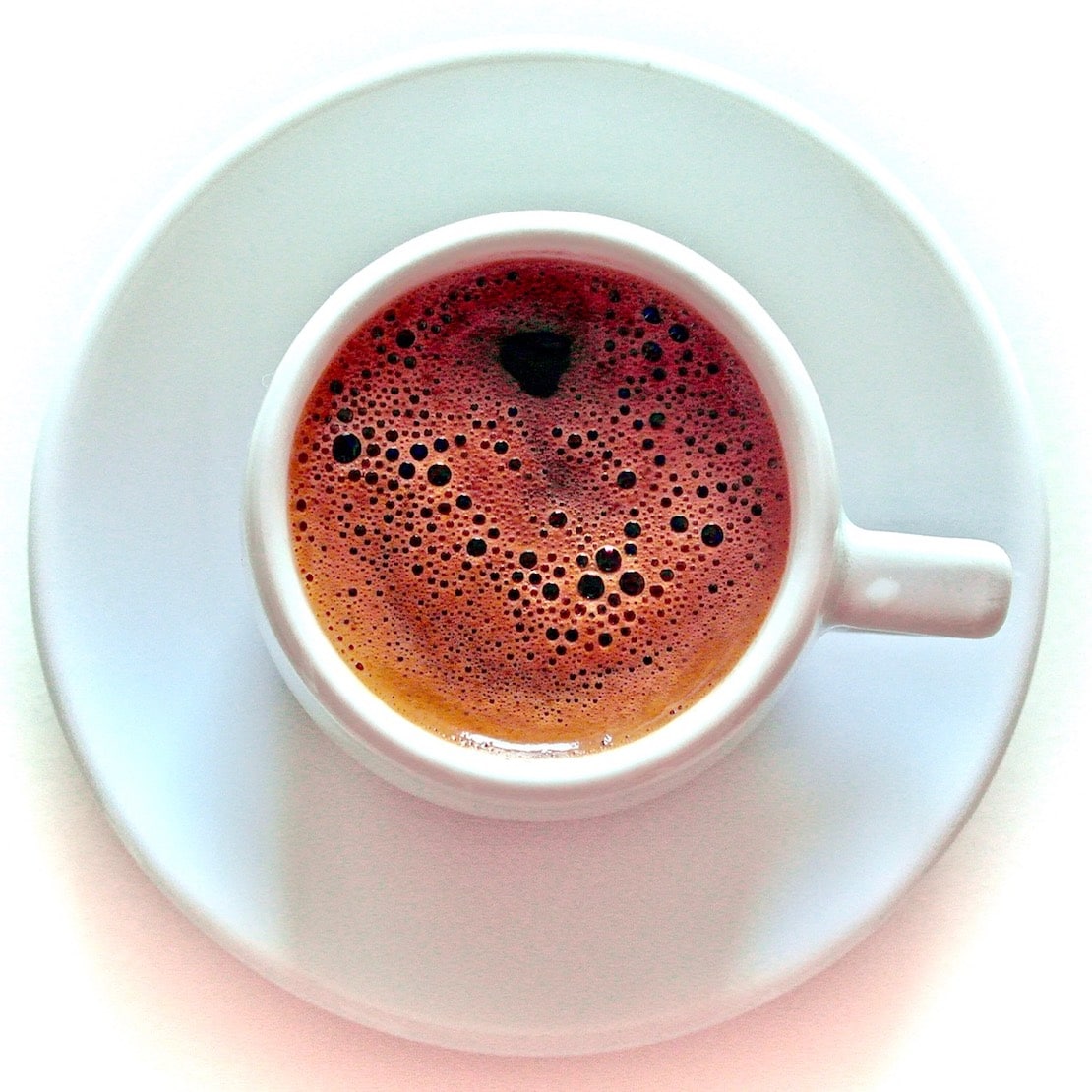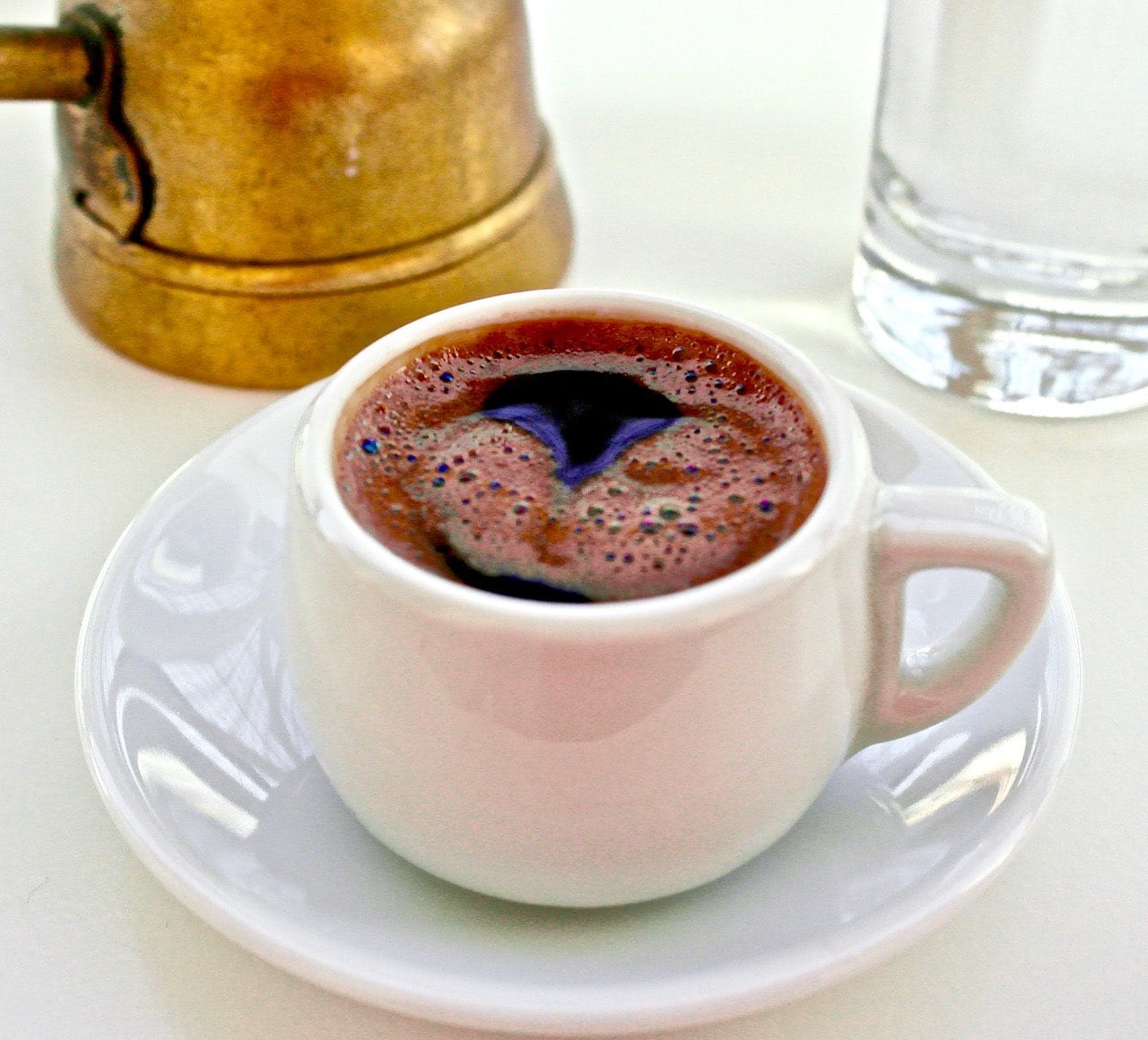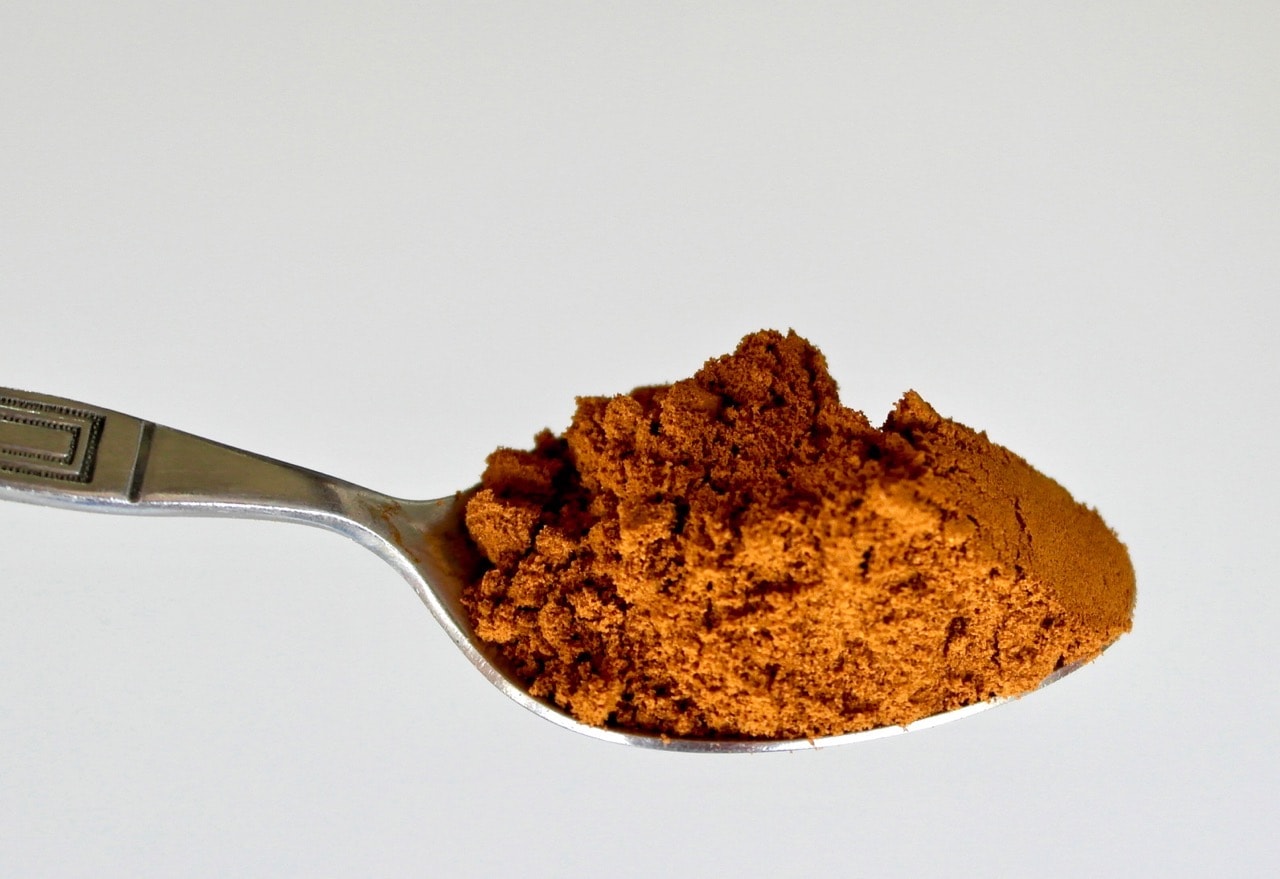Greek Coffee
Learn how to make authentic Greek coffee and how to enjoy it. This boiled Greek coffee has a rich, smooth flavor and a velvety texture, with a wonderful sweet aroma.

The aroma of Greek coffee always brings me right back to my childhood. Mornings started with that familiar aroma, as I would walk in the kitchen, my mom had prepared her coffee and was looking forward to enjoying it, while we had our breakfast. But what I remember and still enjoy even more are the afternoons, when later as an adult we’d have Greek coffee together after the “mesmeri”, the Greek quiet time. Greek coffee has always been more than just a drink; it’s a part of our day, no matter the time. Even now, whenever I visit my parents, my mom always asks me to make her a cup because, as she says, I make it just right.
The variations are limitless. Although you obviously won’t add milk or syrups to it, however the ratio of sugar to coffee, the amount of coffee, the length of time it is boiled, whether it has bubbles or not, all these are factors that can affect the taste and texture of the coffee. So in this post I will show you how I make the coffee and present the numerous other ways it can be prepared.
What is Greek Coffee?
Greek coffee is a finely ground coffee that is boiled. The consistency is rich but also mild tasting, milder than espresso. It also has less caffeine than espresso. To prepare it, the coffee is added to water and then heated slowly on low heat. Eventually the coffee becomes thick, developing a nice foam on top. It is served in demitasse cups, they are slightly larger than an espresso cup. Greek coffee differs in several ways from other coffee. It is made from a combination of variety of Santos which is an Arabica variety, and Robusta which provides the creaminess.
The texture is very fine and what makes the biggest difference in flavor is the way it is roasted. Greek coffee tends to be milder than other types of similar (Turkish/Arab) coffee, this comes down to roasting method. In addition, Greek coffee does not contain any spices such as cardamon which you may find in other similar types of coffee.
I need to note that you can’t just grind your favorite coffee beans in a fine powder and expect to have Greek style coffee. This is not the case. Α specific combination of beans is used to make this Greek blend, with specific bean varieties, roasted at specific temperatures and used in specific ratios. If there is a place that grinds/roasts Greek/Turkish/Arab style coffee near you, then by all means get the coffee from there. If not, many ethnic super markets sell it and you can also order Greek coffee from Amazon, they carry the 2 popular Greek brands Loumidis and Bravo.
Greek Coffee Health Benefits: The Dietitian’s Take
We have known for a while that coffee can be good for you and particularly Greek style coffee as a recent study on elderly Greeks showed us. Greek coffee contains high amounts of cafestol and kahweol, substances that appear to have ant-inflammatory and antioxidant properties. In addition, Greek style coffee has moderate caffeine levels. A few years ago, a similar Greek study about Greek coffee found that consumption of Greek coffee improved the elasticity of arteries in individuals with high blood pressure. In another study that was conducted on the inhabitants of the Greek island of Ikaria who have one of the highest longevity rates, it was found that those who consumed Greek coffee regularly had better endothelial function than those who consumed other types of coffee. The endothelial is a group of cells that line the interior of blood vessels. When these cells are not functioning properly, it may lead to atherosclerosis-hardening of the arteries.
Greek Coffee Ingredients and Equipment
You will need some equipment to make a proper Greek coffee.
- A gas source. In Greece most people used to have gas stove tops, nowadays these have been replaced with electric stove tops, which I am not very fond of, as I cannot see flame. Since most people no longer have gas stove tops, here they use what you call a gazaki, it is a single camping gas burner. Traditionally this type of coffee is made in what is called hovoli, which is basically heated sand.
- Get a small coffee pot called a briki. There are different sizes, I like to have 2 sizes, one that can make only 1 serving and one for 2 servings.
- Espresso coffee cup or Greek coffee cup like the one in the photo
- Greek Coffee: Make sure you use Greek brands as the coffee has a different roasting method and a different intensity, it is milder generally. You can use other brands but they may be stronger or also have spices added to them.
- Sugar. Do not use sugar substitutes or brown sugar, you will not get the texture or flavor you are looking for.
How To Make Greek Coffee

- Measure out a full coffee cup of water (about 2 1/2 -3 ounces or 75-90 mls) and pour into the briki. If you are making more than one coffee make sure your briki is big enough, you will need space to let the coffee bubble and foam.
- Add 2 teaspoons of coffee and 2 teaspoons of sugar for every 1 coffee cup and stir. This ratio is considered a somewhat strong coffee.
- Place the briki on the gas and turn on so that it is on low heat.
- Very slowly let the coffee heat up, (keep the flame very-very low). Do not leave the coffee unattended.
- You will slowly see the surface start to tremble (I describe it like a volcano waiting to explode). Once it starts foaming, lift it slightly from the heat until the foam/bubbles settle and then put it on the fire again and let it start foaming and puffing up. Then remove. This step is important to get a good coffee. You don’t want to let it over-boil otherwise it will not have that creamy/foam on top, but you don’t want it under-boiled because then you may taste the grounds in the coffee.
- Serve in the coffee cup. If you are making more than one, separate the foam in each coffee cup. However, I prefer to make each coffee separately or at most 2 servings per brick.
- Serve the cup on a small saucer with a glass of cold water.
How to drink Greek coffee
While this is a small coffee, it is not to be confused with the espresso, which is basically consumed quickly standing up. This coffee is consumed sitting down slowly, it will usually take at least 1/2 hour. To get the full flavor you should sip the coffee slowly. I remember the older generations taking loud sips of coffee; while this may be rude, I find that it increases the enjoyment of the coffee. Once you start tasting the first grounds you are done. Do not try and drink the coffee grounds at the bottom of the cup.
In Greece, traditionally coffee was consumed two times a day: In the morning and in the afternoon after their nap. Although the coffee seems thick and black it is not extremely high in caffeine, it is actually lower than regular filter coffee.
What to Serve with Greek Coffee
Greek coffee is always served with a glass of cold water. You can accompany it with a sweet, the classic accompaniment is a koulouraki such as the classic Koulourakia- Greek Butter Cookies, or the vegan version Olive Oil Cinnamon Cookies – Kolourakia Lathiou, you can also accompany with bite-size sweets such as these Greek Island Almond Sweets – Amygthalota or these Almond-Cocoa Bites.
Different Preparations of Greek Coffee
As I mentioned earlier there are different ways to enjoy coffee (some say that there are 45 different ways to prepare Greek coffee), so you may always reduce the sugar or not add any at all. The way I make it is considered somewhat moderate to strong. Here are some of the ways it can be consumed:
- Plain pronounced Sketos: Only coffee and no sugar
- Strong pronounced Varis : 2-3 teaspoons of coffee with 1 teaspoon sugar
- Light pronounced Elafris : ½-1 teaspoon of coffee + 1 teaspoon sugar
- Sweet pronounced Glykos : 1 teaspoon coffee +2 teaspoons sugar
- Strong-Sweet pronounced Variglykos : 3 teaspoons coffee +3 teaspoons sugar
- Yes and No pronounced Ne ke Ohi : 1 teaspoon coffee + ½ teaspoon sugar
Insider Tips to Make the Best Greek Coffee
I don’t mean to brag but the elders in my family tell me I make the best Greek coffee. Here are my tips:
- Don’t make large amounts all at once. Good Greek coffee is made in separate servings, so make sure you have an appropriate sized briki as it is important for proper boiling and foam development. If it is too big your coffee will boil too quickly.
- Use the correct coffee. Again make sure you buy the right kind, otherwise it will taste nothing like real Greek coffee.
- Don’t hurry it. Greek coffee needs a few minutes, not too long but you also don’t want it to quickly boil it either. And you definitely don’t want it to come to a complete boil either, this will result in no foam.
- Pay attention to the ratio of sugar to coffee, see the amounts above and experiment.
Greek Coffee

Equipment
- 1 Small coffee pot called a briki
Ingredients
Special Equipment
- Gas Source see above
- Small coffee pot called a briki.
- Espresso cup or Greek coffee cup
Instructions
- Measure out a full coffee cup of water (about 2 1/2 -3 ounces or 75-90 mls) and pour into the briki. If you are making more than one coffee make sure your briki is big enough, you will need space to let the coffee bubble and foam.
- Add 2 teaspoons of coffee and 2 teaspoons of sugar for every 1 coffee cup and stir. This ratio is considered a somewhat strong coffee.
- Place the briki on the gas and turn on so that it is on low heat.
- Very slowly let the coffee heat up, (keep the flame very-very low). Do not leave the coffee unattended.
- You will slowly see the surface start to tremble (I describe it like a volcano waiting to explode). Once it starts foaming, lift it slightly from the heat until the foam/bubbles settle and then put it on the fire again and let it start foaming and puffing up. Then remove. This step is important to get a good coffee. You don’t want to let it over-boil otherwise it will not have that creamy/foam on top, but you don’t want it under-boiled because then you may taste the grounds in the coffee.
- Serve in the coffee cup. If you are making more then one, separate the foam in each coffee cup.
- Serve the cup on a small saucer with a glass of cold water.
Notes
- Plain pronounced Sketos: Only coffee and no sugar
- Strong pronounced Varis: 2-3 teaspoons of coffee with 1 teaspoon sugar
- Light pronounced Elafris: ½-1 teaspoon of coffee + 1 teaspoon sugar
- Sweet pronounced Glykos: 1 teaspoon coffee +2 teaspoons sugar
- Strong-Sweet pronounced Variglykos: 3 teaspoons coffee +3 teaspoons sugar
- Yes and No pronounced Ne ke Ohi: 1 teaspoon coffee + ½ teaspoon sugar


Thank you so much! Excellent explanation of the different ways to make. Have already ordered it!
Great exploration for a novice! Thank you! One tip I was given was to half fill the first cup then fill the second and then top up the first and that way both cups should enjoy the same strength and texture of the coffee!
Yes, you also want to make sure both cups have a bit of foam on the top (kaimaki).
Elena,
I have been using your recipes and purchased your book! You are an amazingly creative recipe writer, giving me a wonderfully detailed REAL MEDITERRANEAN DIET that has changed not only my way of shopping and preparing meals, but it lowered my cholesterol from 300 to 274! I’m 67 years old (now weighing 120lbs) and I am going to stay on this way of eating for the rest of my days!! THANK YOU SO MUCH for your knowledge, talents of cooking and SHARING your experiences!!
Congratulations Barbara! That is impressive. Thank you for your kind words.